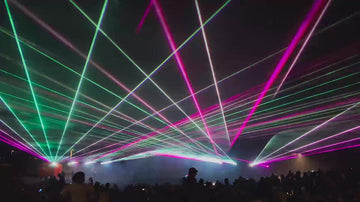All Articles
The Safety of Lasers and Laser Equipment: Exploring Risks and Best Practices
by MIYA LASERS on Oct 24, 2023

For individuals considering the purchase of laser light projector and laser equipment, a fundamental question frequently arises: Just how safe are these devices? Are there inherent risks associated with their usage? This article delves into the multifaceted world of lasers, discussing the various types available, safety guidelines, and crucial considerations for operators and spectators.
Laser Diode: Features and Functionality

A laser apparatus incorporates a crucial component known as a laser diode, which emits an intensely concentrated beam of light with exceptionally high luminous intensity. This diode, though relatively diminutive in size, employs technology reminiscent of light-emitting diodes (LEDs), albeit with a significant distinction: its ability to generate a directional, high-intensity beam. Laser diodes are accessible in a spectrum of colors, with the most common combinations being red, green, and blue (RGB). Green diodes yield the highest light intensity, followed by red and blue. Notably, green laser diodes provide optimal light output and are comparatively cost-effective to manufacture, thus accounting for their prevalence. Similar to high-powered LEDs, it is imperative to maintain the optimal operating temperature of laser diodes to ensure efficiency and longevity.
The Laser Pointer: Potential Hazards
Contrary to common perception, the seemingly innocuous laser pointer, frequently employed in presentations, can be among the riskier laser devices, especially those with higher output capacities. Most laser pointers feature a red laser diode, generating a light output of approximately 5 milliwatts (mW), sufficient for projecting a visible red dot onto a screen to highlight specific points. However, certain laser pointers are capable of emitting light intensities of up to 200 mW, posing a substantial risk when directed into an individual's eye. Fortunately, laser pointers of this magnitude are considerably rarer in today's market.
Popular Types of Show Lasers

One emerging trend in entertainment lasers is the grating laser, which incorporates laser diodes and laser pointers but is notably less hazardous. Grating lasers produce dynamic laser patterns or figures projected onto surfaces such as walls, ceilings, and dance floors. Conversely, traditional show laser light projector function differently. Instead of employing an effects wheel, traditional laser light projector employ two mobile mirrors, known as a scan set. Each mirror is affixed to a stepper motor, with one responsible for horizontal beam movement and the other for vertical beam movement.
Professional Laser vs. Budget Laser: Safety Considerations
Distinguishing between the safety of professional and budget laser light projector involves several key factors. The heightened speed of professional lasers significantly reduces the likelihood of stationary beams causing damage. Conversely, budget laser light projector have lower light intensity, diminishing the potential hazard posed by the laser beam itself. Professional laser light projector typically feature additional safety measures, but it is essential to emphasize that both categories require responsible handling. Legislation concerning the use of show lasers at events, permanent installations, and parties is relatively permissive, albeit with the stipulation that laser light projector operators must maintain vigilant oversight over the operational status of lasers in use, ready to intervene if necessary. Regardless of cost, it is imperative never to leave a laser light projector unattended.
The safety of laser light projector and laser equipment hinges on a combination of factors, including the type of laser, its power output, and responsible operation. By understanding the intricacies of different laser devices and adhering to safety guidelines, users can enjoy the benefits of laser technology while minimizing risks to themselves and others.
Understanding Laser Classes
Class 1 - Completely Safe
Class 1 lasers are considered completely safe. They are enclosed, preventing any exposure to the laser light. An example is a CD player.
Class 2 - Safe with Blink Reflex
Class 2 lasers are safe for normal use. Blinking your eye will provide adequate protection from any potential harm. This class includes laser pointers with a light yield of up to 1 mW.
Class 3R (formerly IIIa) - Low Risk of Eye Damage
Class 3R lasers pose a small risk of eye damage. Staring directly into the beam can harm the retina. These lasers have power outputs of up to 5 mW.
Class 3B - Relatively Hazardous
Class 3B lasers are relatively hazardous and can cause immediate eye damage upon exposure to both direct and scattered light beams. They typically have power outputs ranging from 5 to 500 mW.
Class 4 - Highly Hazardous
Class 4 lasers are highly hazardous and can burn the skin. In some cases, even scattered light can cause eye and skin damage. Many industrial and scientific lasers fall into this class, with power outputs of 500 mW or more.
Safety Regulations for Laser Products
Retailers are legally allowed to sell laser pointers and laser devices classified as Class 2, 2M, 3R, 3B, and 4. However, products classified as Class 2 or higher must include an official warning symbol.

Photography and Filming Safety during Laser Shows
When capturing images or videos during a laser show, it's crucial to recognize that your camera's sensor is highly sensitive to laser intensity, even more so than the human eye's retina. To ensure the safety of your camera equipment, be cautious when filming or taking photos at events featuring lasers. Never position yourself in the path of a laser beam while doing so.
In conclusion, responsible and safe laser usage is paramount. Always avoid direct exposure to laser beams, whether with your eyes or camera equipment. Additionally, ensure that lasers are never left unattended. If you have any doubts or uncertainties, educate yourself about the associated risks. Laser safety is everyone's responsibility, whether you are an operator or a spectator.
